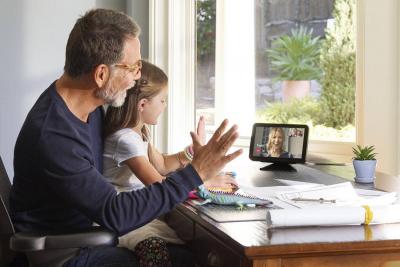
While it's important for all of us to keep in touch with family and friends during the coronavirus outbreak, it's especially important to check in with older relatives, friends and neighbours to make sure that they're okay. They're most at risk of becoming isolated, and they may have to live with the lockdown for longer.
Fortunately, video calling has made it a whole lot easier to stay in touch. It may sound like a daunting prospect to older people who aren't confident with technology, but it doesn't need to be.
If they've got a smartphone, tablet or laptop, then there are loads of free apps to try, from services that most of them probably already use. Or if that's too much, you can set them up with a video chat device that requires no tech know-how at all.
Video chat software
The easiest options for video calling are by using services that everyone already has access to. If you and the person you're calling use Apple devices, then this is likely to mean FaceTime. If not, then most people have a Facebook or Google account - or both - and both offer their own video chat services.
You can use Facebook Messenger through a dedicated app on your phone, or with the webcam on a laptop, just by logging in to your account in the Chrome or Microsoft Edge browser as you normally would. You can chat with up to 50 people at once, so it's ideal for virtual family get togethers.
Likewise, Google Duo runs in most browsers as long as you're signed in to your account, and it should also be pre-installed on every Android phone or tablet. Up to 12 people can join in a call, and you just need their Google address or phone number to invite them. If you need more than 12 people, take a look at Google Meet. This is primarily a business tool for video conferencing, but Google are now making it free for everyone. You can add up to 100 people to your call, and chat for an hour.
If the person you're calling has a smartphone or tablet, then WhatsApp is another good choice to look into. You - and the people you're calling - will need to install the app from the app store, but the setup process is minimal. When you first launch WhatsApp you just need to register your phone number by entering a short code you'll be sent by text. After that, you're good to go. Just tap the green Chat icon in the bottom right corner, select a contact or create a new group to start a group chat, then hit the Video Call button to begin.
And then there's Zoom, which has become one of the big names in video chat during the lockdown. Similar to Google Meet, you can add up to 100 people to your call, and chat for 40 minutes at a time. It's pretty easy to get started with. The person who starts and hosts the call will need to create a Zoom account first, and can then invite people to join by sending them a link or code via email or text message. People joining the chat don't even need to create an account, although they will have to install the Zoom app on their laptop or phone first.
Video chat hardware
Even easier than using software on your phone or laptop is using dedicated hardware. These devices tend to be plug and play, so once you're connected and logged in there's no other configuration needed. They're ideal for less tech-savvy users - especially if you set it up yourself before you give it to them.
You've probably seen the TV ads for Facebook Portal, which is a series of tablet-style video calling devices starting with an eight-inch model priced at £129. Portal is easy to set up - you just need to connect it to your Wi-Fi network and log in to your Facebook account - and then it's ready to use. The best thing is that it works with WhatsApp and Facebook Messenger as well, so not everyone on the chat needs to buy the hardware to join in the fun.
Google have their own equivalent in the form of the Google Nest Hub Max, albeit at a pricier £219. This is part digital photo frame, part hands-free Google Assistant smart speaker, part home security system, and part video calling device. It works with Google Duo for the latter, which, as we've seen, comes on every Android phone and is also available as an iPhone or iPad app.
And there's also Amazon's Echo Show, which is the most affordable option, starting at £79.99 for a 5.5 inch model. This combines the Alexa smart speaker tools with the ability to make video calls to any device with the Alexa app installed - this could be another Echo device, an Amazon Fire HD tablet, or an iPhone or Android phone running the app. What makes this especially user friendly is that when you buy it you can have it automatically set up with your Amazon account details, and even linked to your Wi-Fi network in some cases.
The right broadband for video calls
Video calling doesn't require very much bandwidth, so is usable even on slower broadband plans. The quality of the video drops to a level that is right for your broadband speed.
But if you, or a family member, are becoming more reliant on video calling as well as things like TV streaming or getting used to the demands of working from home, it may be a good time to consider upgrading your broadband to something faster. Use our postcode checker to find the best broadband deals in your area today.
Posted by Andy Betts on in Features
